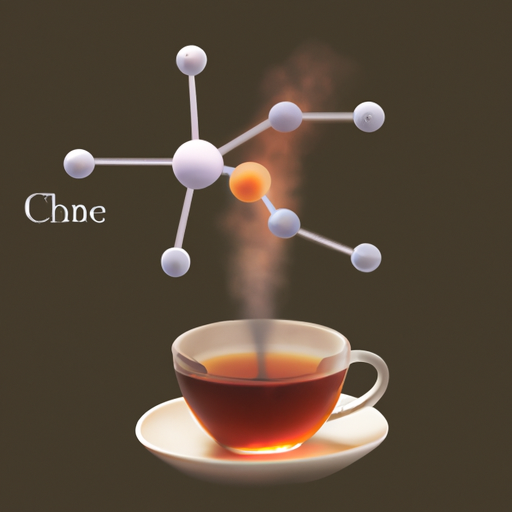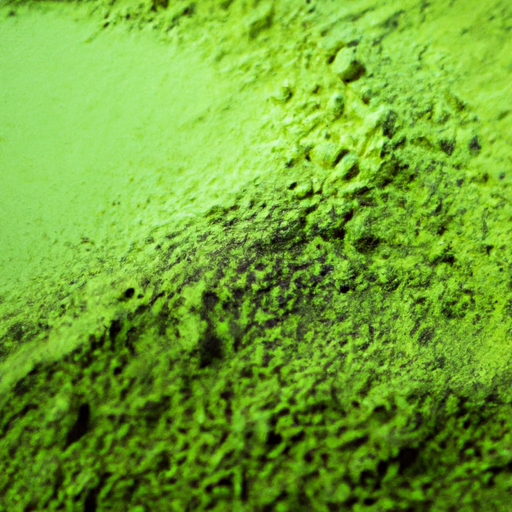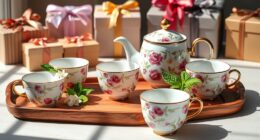As someone who’s passionate about matcha, a critical item in my collection is my matcha scoop. This straightforward yet invaluable utensil enables me to perfectly portion the right quantity of matcha powder for my daily tea ritual.
However, when I first started using matcha spoons, I was unsure about how much powder they held and how to use them correctly. In this article, I will provide you with all the information you need to know about matcha spoons.
From their history and different designs to how to choose the right one for your needs and alternative ways to measure your matcha powder, we will cover it all. So whether you are new to the world of matcha or simply looking for more information on this tiny but mighty tool, keep reading to learn just how big a matcha spoon really is.
Key Takeaways
- Matcha spoons come in two sizes: traditional and small.
- It’s important to use a food-safe matcha spoon and to properly maintain it.
- The correct amount of matcha powder is crucial for a perfect cup of tea, and using a matcha spoon allows for precise measurements.
- Alternatives to using a matcha spoon for measuring include teaspoons, tablespoons, and small kitchen measuring cups, but a kitchen scale provides the most precise measurements.
History of Matcha Spoons
You might be wondering about the history of matcha spoons, so let me tell you that they were first used in Japan during traditional tea ceremonies centuries ago.
The origin of matcha spoons can be traced back to the 16th century when tea masters started using them to measure out the right amount of powdered green tea for each guest. These spoons, also known as chashaku in Japanese, were made from bamboo and had a unique shape that allowed them to scoop up just the right amount of matcha.
Over time, the design of matcha spoons has evolved to meet different needs. In modern times, there are many variations on the original bamboo spoon, including ones made from metal or plastic.
Some designs feature long handles for easy scooping while others have a flat bottom that makes it easy to level off your measurements. Despite these changes, however, matcha spoons remain an essential tool in preparing and enjoying this delicious drink.
So if you’re interested in making your own cup of matcha at home but don’t know where to start when it comes to measuring out the right amount of powder, consider investing in a good quality matcha spoon. With its precise measurements and rich history dating back centuries ago, using a traditional chashaku is sure to add an authentic touch to your tea-making experience.
How to Choose the Right Matcha Spoon
Imagine you’re a chef preparing your signature dish, and the key to its success is selecting the perfect utensil for measuring out the delicate green tea powder. This is where the matcha spoon comes in.
Matcha spoons are typically made from bamboo, but can also be found in other materials like ceramic or metal. The most important thing when choosing a matcha spoon is to make sure it’s made from food-safe materials.
Another factor to consider when selecting a matcha spoon is size. Matcha spoons generally come in two sizes: traditional and small. The traditional size holds approximately 1 teaspoon of matcha powder, while the small size holds about half that amount. It’s important to choose a spoon that best fits your needs depending on how much matcha you plan on using per serving.
Now that you’ve selected your perfect matcha spoon, it’s time to learn how to use it properly. Simply scoop up the desired amount of matcha powder with your spoon and sift it into your bowl using a fine mesh strainer or sifter. This will help ensure there are no clumps or lumps in your matcha before adding water or milk.
How to Use a Matcha Spoon
When it comes to using a matcha spoon, I find that proper technique is essential.
First, I like to whisk the powder in a zigzag motion until it becomes frothy and smooth.
Second, measuring the correct amount of matcha powder is crucial for the perfect cup.
Too little may result in a bland taste, while too much can make it bitter.
Proper Technique
To achieve the perfect matcha consistency, it’s important to use a matcha spoon with proper technique. Proper technique involves a few key brewing tips that can make all the difference. Here are some things to keep in mind when using your matcha spoon:
- Hold the spoon vertically and insert it gently into the powder.
- Scoop up just enough powder to fill the scoop without compacting it.
- Tap the sides of the scoop lightly on the rim of your bowl or mug to release any excess powder.
- Slowly pour hot water over the powder while whisking vigorously in a zigzag motion.
- Use a consistent pace and pressure while whisking to create a smooth, frothy texture.
By following these simple steps, you’ll be able to produce a perfectly brewed cup of matcha every time.
Now that we’ve covered proper technique, let’s move on to measuring the correct amount of matcha powder for each cup.
Measuring the Correct Amount of Matcha Powder
You’ll want to measure out the perfect amount of matcha powder for each cup to ensure that your matcha is delicious and not too bitter. Using a matcha spoon is the traditional way of measuring out your matcha, but there are also other alternatives you can use if you don’t have one available.
Here’s a table that shows different alternatives to using a matcha scoop, as well as common mistakes people make when measuring out their matcha:
| Matcha Scoop Alternatives | Common Measuring Mistakes |
|---|---|
| Teaspoon | Using too much or too little powder |
| Tablespoon | Not sifting the powder beforehand |
| Small kitchen measuring cup | Scooping from the bottom of the bag instead of gently shaking and then scooping from the top |
Remember to always sift your matcha powder before measuring it out and avoid making any of these common mistakes in order to get the perfect cup every time. In the next section, we will discuss how to properly clean and maintain your matcha spoon.
Cleaning and Maintaining Your Matcha Spoon
Proper maintenance of your matcha spoon involves gently wiping it clean after each use with a soft cloth. It’s important to remove any excess powder from the spoon to prevent buildup and ensure accurate measurements in the future. Here are some cleaning tips and storage ideas for your matcha spoon:
- Use a dry, soft cloth or paper towel to wipe off any remaining powder on the spoon.
- If there’s stubborn residue, lightly dampen the cloth with water and wipe it again until all the residue is removed.
Store your matcha spoon in a cool, dry place away from direct sunlight or heat sources. Avoid washing your matcha spoon with soap or placing it in the dishwasher as this can damage its delicate structure.
By properly cleaning and storing your matcha spoon, you can prolong its lifespan and ensure that it continues to provide accurate measurements for years to come. In the next section, we’ll explore alternative ways to measure matcha powder without using a traditional bamboo scoop.
Alternative Ways to Measure Matcha Powder
When I first started making matcha, I didn’t have a matcha spoon and wasn’t sure how to measure the powder accurately. After some experimentation, I found that using a regular teaspoon worked well.
However, for those who prefer more precision in their measurements, using a kitchen scale can provide accurate and consistent results every time.
Using a Regular Spoon
Using a regular spoon is an easy and convenient way to measure out your matcha. While it may not provide the same level of measuring accuracy as using a matcha spoon or kitchen scale, it’s a great option for those who don’t have these tools on hand or prefer not to use them. Additionally, using a regular spoon can save time and make the process of making matcha more efficient.
To help ensure that you’re getting the right amount of matcha powder when using a regular spoon, here are some general guidelines in table format:
| Spoon Size | Amount |
|---|---|
| Teaspoon | 2-3 grams |
| Tablespoon | 6-9 grams |
It’s important to note that these measurements may vary slightly depending on the size and shape of your spoons. However, this method can still be useful for achieving consistent results with your matcha drinks.
If you’re looking for even greater measuring accuracy, using a kitchen scale is another option.
Using a Kitchen Scale
For the most precise measurements, you’ll want to grab your kitchen scale and weigh out your matcha powder like a master chef. Imagine yourself carefully pouring out the perfect amount of vibrant green powder onto the scale, watching as it settles into place with satisfying accuracy.
Measuring accuracy is key when making a delicious cup of matcha, and using a kitchen scale allows you to achieve this with ease. However, there are some common mistakes that people make when measuring their matcha powder on a kitchen scale.
To ensure you get the perfect amount every time, keep these tips in mind:
- Always zero out your scale before measuring
- Use grams instead of ounces for more accurate measurements
- Don’t pack the matcha powder into the spoon or onto the scale
- Keep an eye on how much powder you are adding to avoid over-measuring
- Be consistent with your measurements each time
Using a kitchen scale may seem like an extra step in making matcha, but it allows for greater measurement precision and ultimately leads to a better tasting cup. Now let’s explore the benefits of using a matcha spoon.
Benefits of Using a Matcha Spoon
Using a matcha spoon to measure out my matcha powder has been a game changer for me. It not only provides consistent results every time, but it also helps preserve the quality of the powder.
By using a designated tool for measuring and handling the matcha, I’m able to ensure that each cup I make is just as delicious as the last.
Consistent Results
To achieve consistent results, you’ll want to make sure your matcha spoon is the same size every time. This is where matching tools and precision measuring come into play.
A matcha spoon, also known as a chashaku, is typically made of bamboo and measures around one gram of matcha powder per scoop. It’s important to note that not all spoons are created equal; some may hold slightly less or more powder than others.
Using a consistent amount of matcha powder each time ensures that your cup of tea will taste the same with every brew. Consistency also helps when experimenting with different recipes that require specific amounts of powder.
By using a precise measuring tool like a matcha spoon, you can achieve accurate measurements without having to eyeball it or guess how much powder you’re using.
With this in mind, let’s move on to preserving the quality of matcha powder by discussing proper storage techniques.
Preserving the Quality of Matcha Powder
Congratulations, you’ve invested in high-quality matcha powder! Now it’s time to learn how to keep that vibrant green color and fresh flavor intact. Storing matcha properly is essential for preserving its quality.
Here are some tips on how to do it:
- Keep your matcha in an airtight container: Oxygen can quickly degrade the quality of matcha powder, making it lose its flavor and color. Therefore, storing it in an airtight container will help prevent oxidation.
- Store your matcha in a cool and dark place: Heat, light, and humidity can also affect the freshness of your matcha. It’s best to keep it away from direct sunlight or any heat sources.
- Use silica gel packets: To further protect your matcha from moisture, you can include silica gel packets inside the container.
- Prevent clumps by sifting before use: Clumps often form when there’s too much moisture present in the powder. Sifting before adding water or milk will help break down any lumps.
By following these simple steps, you’ll be able to extend the shelf life of your matcha powder while keeping its quality intact.
Next up, let’s talk about popular matcha spoon designs.
Popular Matcha Spoon Designs
You’ll love the unique and elegant designs of popular matcha spoons, each one adding a touch of sophistication to your tea ceremony. Matcha spoon styles vary from traditional bamboo chashaku to modern stainless steel or ceramic spoons. The type of spoon you choose depends on your personal taste and matching utensils.
Take a look at this table showcasing different popular matcha spoon designs:
| Spoon Design | Material | Description |
|---|---|---|
| Chashaku | Bamboo | A traditional Japanese scoop used in the tea ceremony. It has a long handle with a curved tip that can measure out just the right amount of matcha powder. |
| Dosing Scoop 2-in-1 teaspoon and tablespoon scoop for measuring both loose leaf tea and matcha powder. Made from stainless steel, it is durable and easy to clean. | ||
| Ceramic Spoon | Ceramic | A delicate spoon that adds an artisanal feel to your tea-making process. It is available in various colors and designs, making it easy to coordinate with other utensils in your collection. |
| Long Handled Spoon | Stainless Steel | This spoon features an extra-long handle that reaches deep into tall containers, such as canisters or jars, to easily scoop out every last bit of matcha powder. |
Now that you know about some popular matcha spoon designs, you may be wondering where you can buy them. There are many retailers online that sell these spoons, including specialty tea shops, kitchenware stores, and e-commerce websites like Amazon or Etsy. Consider purchasing multiple styles so you can switch up your tea-making routine and find the perfect match for your favorite teapot or bowl!
Where to Buy Matcha Spoons
If you’re looking for a place to purchase matcha spoons, check out online retailers like Amazon or Etsy for a variety of styles and designs. These platforms offer many buying options that can cater to your needs. Here are some examples of where to buy matcha spoons:
-
Amazon – This online retailer offers an extensive collection of matcha spoons from various sellers worldwide. You can choose from different materials such as bamboo, ceramic, or metal. The prices range from affordable to high-end depending on the design and quality.
-
Etsy – If you’re looking for unique and handmade matcha spoon designs, Etsy is the perfect platform for you. There are many independent sellers who create personalized and one-of-a-kind matcha spoons that can fit your preference. You can also support small businesses by purchasing from this platform.
-
Specialty stores – Some tea shops and Japanese specialty stores may carry matcha spoons in-store or online. These stores usually offer authentic Japanese-made matcha utensils that have intricate designs and craftsmanship.
In terms of styles available, there are various shapes and sizes of matcha spoons to choose from depending on how much powder you want to measure per serving. Some popular styles include the chashaku style which resembles a thin spatula with a curved handle, while others have more scooped-out bowls for larger servings. Whatever design you prefer, make sure it fits your needs when measuring your daily dose of matcha powder accurately.
Frequently Asked Questions
What is the nutritional value of matcha powder?
Matcha powder is an antioxidant-rich, ground green tea that has been used in Japanese tea ceremonies for centuries. It’s a versatile ingredient that can be incorporated into a variety of recipes, from matcha lattes to matcha smoothies.
As for its nutritional value, matcha powder is packed with nutrients such as vitamins A and C, iron, potassium, and fiber. It’s also high in catechins, a type of antioxidant that has been shown to have anti-inflammatory properties and may help protect against certain cancers.
Personally, I love adding matcha powder to my morning smoothie for an extra boost of energy and antioxidants. Plus, it adds a subtle earthy flavor that pairs well with fruits like banana or mango. As they say, "matcha made in heaven!"
Can matcha powder be used in baking?
Yes, matcha powder can be used in baking. I love adding it to my coffee and smoothies for an extra boost of antioxidants and caffeine, but it also works great as a flavoring in baked goods like muffins, cookies, and cakes.
The earthy taste of matcha pairs well with sweet flavors like vanilla or chocolate, and its bright green color adds a fun pop to any dessert. When using matcha powder in baking, make sure to sift it first to remove any clumps and achieve a smoother texture.
Additionally, keep in mind that a little goes a long way – you don’t want your baked goods to taste too bitter or overpowering. Experiment with different recipes and find the perfect balance of matcha flavor for your personal taste preferences!
What is the best way to store matcha powder?
When it comes to storing matcha powder, it’s important to keep it in an air-tight container to prevent exposure to light and moisture. Some people prefer to store their matcha in the fridge, while others opt for a cool pantry. The key is to keep the powder away from heat and humidity.
To ensure freshness, it’s recommended that you consume your matcha within 2-3 months of opening the package. If you’re looking for ways to extend its shelf life, consider freezing small portions of the powder in ziplock bags or vacuum-sealed containers.
It’s also worth noting that matcha has significant cultural significance beyond its culinary applications – from tea ceremonies to mindfulness practices and spiritual traditions, this vibrant green powder has been a part of Japanese culture for centuries.
How long does a matcha spoon typically last?
Did you know that a matcha spoon can last for years if properly maintained? Matcha spoon maintenance is crucial to ensure longevity and consistent quality of your matcha tea. Cleaning techniques should involve gentle hand washing with mild soap and warm water, followed by thorough drying with a soft cloth or towel. Avoid using harsh chemicals or abrasive materials that can damage the delicate bamboo spoon.
As for the current question, how long does a matcha spoon typically last? With proper care, it can last indefinitely, making it a worthwhile investment for any matcha enthusiast. So take good care of your matcha spoon, and enjoy that perfect cup of frothy green tea every time!
Are there any health risks associated with using a matcha spoon?
I’ve done extensive research on the possible health risks associated with using a matcha spoon, and I can confidently say that there aren’t any.
However, it’s important to note that the type of material used for the matcha spoon can affect its hygiene. Metal spoons tend to be more hygienic than bamboo ones because they’re easier to clean and don’t absorb moisture as easily.
When comparing a matcha spoon to an electric whisk for preparing matcha, it really comes down to personal preference and convenience. While an electric whisk may be faster and produce a smoother consistency, using a traditional matcha spoon allows for a more authentic tea-making experience.
Ultimately, whether you choose to use a metal or bamboo matcha spoon or opt for an electric whisk is up to you and your individual preferences.
Conclusion
In conclusion, using a matcha spoon is an essential tool for any matcha lover. It not only ensures that you’re using the right amount of matcha powder for your drink, but it also adds a touch of elegance to your tea-making routine.
With various designs and sizes available, it’s easy to find the perfect matcha spoon that suits your taste and needs. As they say, "the proof is in the pudding,"or in this case, "the proof is in the tea."Once you start using a matcha spoon, you’ll notice a significant improvement in the taste and texture of your matcha drinks.
So don’t hesitate to invest in one today and take your matcha game to the next level!










